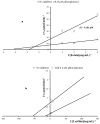Phloroglucinol as a Potential Candidate against Trypanosoma congolense Infection: Insights from In Vivo, In Vitro, Molecular Docking and Molecular Dynamic Simulation Analyses
- PMID: 35056785
- PMCID: PMC8781988
- DOI: 10.3390/molecules27020469
Phloroglucinol as a Potential Candidate against Trypanosoma congolense Infection: Insights from In Vivo, In Vitro, Molecular Docking and Molecular Dynamic Simulation Analyses
Abstract
Sub-Saharan Africa is profoundly challenged with African Animal Trypanosomiasis and the available trypanocides are faced with drawbacks, necessitating the search for novel agents. Herein, the chemotherapeutic potential of phloroglucinol on T. congolense infection and its inhibitory effects on the partially purified T. congolense sialidase and phospholipase A2 (PLA2) were investigated. Treatment with phloroglucinol for 14 days significantly (p < 0.05) suppressed T. congolense proliferation, increased animal survival and ameliorated anemia induced by the parasite. Using biochemical and histopathological analyses, phloroglucinol was found to prevent renal damages and splenomegaly, besides its protection against T. congolense-associated increase in free serum sialic acids in infected animals. Moreover, the compound inhibited bloodstream T. congolense sialidase via mixed inhibition pattern with inhibition binding constant (Ki) of 0.181 µM, but a very low uncompetitive inhibitory effects against PLA2 (Ki > 9000 µM) was recorded. Molecular docking studies revealed binding energies of -4.9 and -5.3 kcal/mol between phloroglucinol with modeled sialidase and PLA2 respectively, while a 50 ns molecular dynamics simulation using GROMACS revealed the sialidase-phloroglucinol complex to be more compact and stable with higher free binding energy (-67.84 ± 0.50 kJ/mol) than PLA2-phloroglucinol complex (-77.17 ± 0.52 kJ/mol), based on MM-PBSA analysis. The sialidase-phloroglucinol complex had a single hydrogen bond interaction with Ser453 while none was observed for the PLA2-phloroglucinol complex. In conclusion, phloroglucinol showed moderate trypanostatic activity with great potential in ameliorating some of the parasite-induced pathologies and its anti-anemic effects might be linked to inhibition of sialidase rather than PLA2.
Keywords: Trypanasoma congolense; anemia; molecular docking; molecular dynamics simulation; phloroglucinol; phospholipase A2; sialidase.
Conflict of interest statement
The authors declare no conflict of interest.
Figures











References
-
- Umar I.A., Maryoms N.G., Daikwo E., Gidado A., Buratai L.B., Ibrahim M.A. The effects of consumption of Hibiscus sabdariffa calyces on heamatological profile and organ pathological changes in Trypanosoma congolense infected rats. Afr. J. Tradit. Complement. Altern. Med. 2009;6:585–591. - PMC - PubMed
MeSH terms
Substances
LinkOut - more resources
Full Text Sources
Miscellaneous

